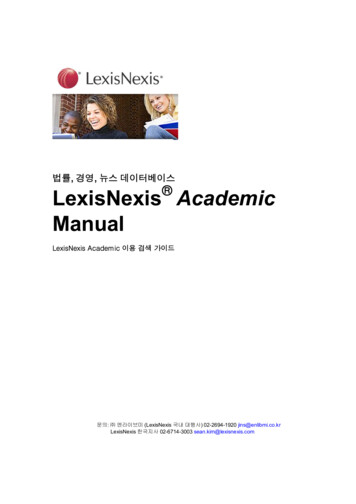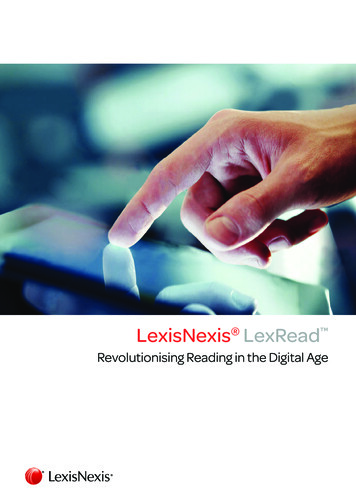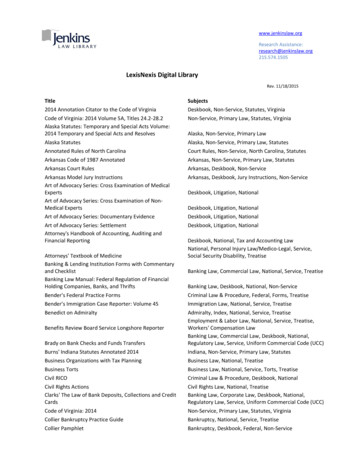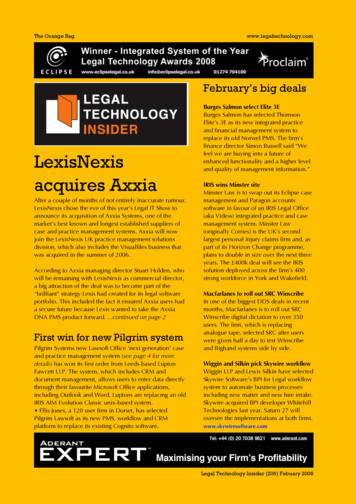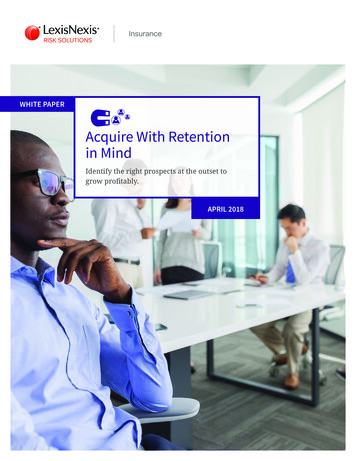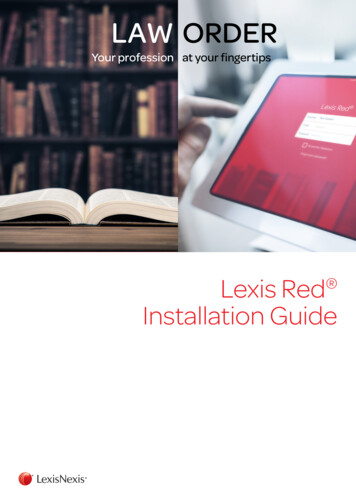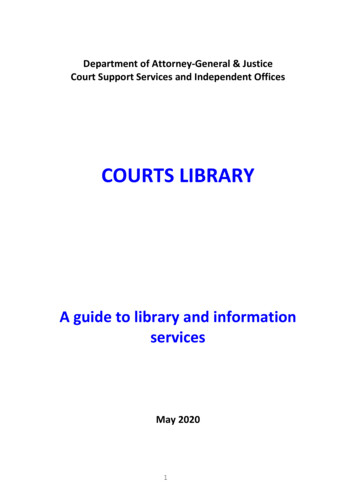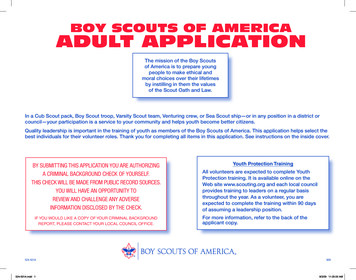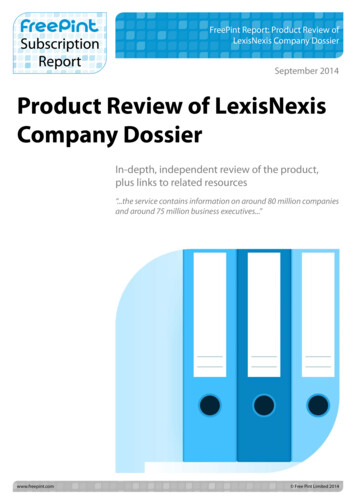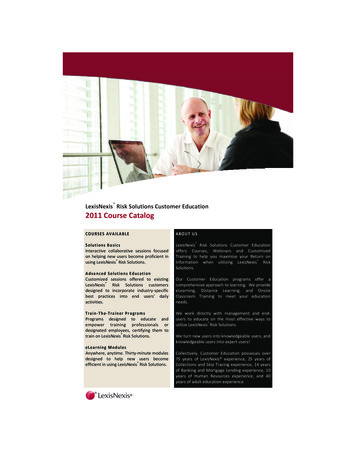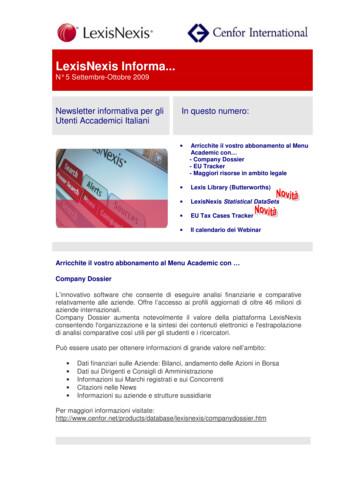
Transcription
BEST PRACTICES 2013TABLE OF CONTENTSLike LexisNexis for Government on rnment)Library Metrics: A Practical GuideBy Karen Krugman, Chief Librarian, Commerce Research Library,Department of Commerce; Karen White, Senior Librarian & Team Lead,USAID Knowledge Services Center, LAC Group on assignment at USAID; KrisVajs, Chief Librarian, Research Library, Board of Governors of the FederalReserve SystemOverview of Legislative History ResearchBy Maureen Booth, Law Librarian, Department of the Interior LibraryLexis Advance: The Top 10 Features and How They Work for YouBuilding a Better Open House in 10 stepsBy Lisa Leyser, Library Director, Federal Communications CommissionBibliometrics: a partial cure for information overload in scientificresearchBy Chris Belter, LAC Group, NOAA Central LibraryTraining staff from Georgia to Guam and All Points in BetweenBy Karen Cooper, Reference Librarian, National Defense University Library;Nancy Faget, Librarian, Army Research Library; Denise Lupp, LibraryDirector, US Army Medical Research Institute of Infectious Diseases; LilyMcGovern, Reference Librarian, National Defense University Library; Wilma"Sissy" Riley, Library Technician, US Army Medical Research Institute ofInfectious Diseases; Trudie A. Root, Librarian of the Army, Headquarters,Dept. of ArmyInstitutional Legacies: Oral History InterviewsBy Leanna E. Bush, Library Technician, US Army Medical Research Instituteof Chemical Defense, Wood Technical Library, Aberdeen Proving Ground, MDTightening Budgets, Evaluating Collections, and Collaborating toDetermine Core CollectionsBy George Franchois, Director, U.S. Department of the Interior LibraryPark Ranger Speaker Series: The Federal TriangleSubmitted by George Franchois, Director, U.S. Department of the InteriorLibrary1
BEST PRACTICES 2013Park Ranger Speaker Series: The Korean War Veterans MemorialSubmitted by George Franchois, Director, U.S. Department of the InteriorLibraryPark Ranger Speaker Series: The Battle of the BulgeSubmitted by George Franchois, Director, U.S. Department of the InteriorLibraryPark Ranger Speaker Series: Creating a Sacred American Space?Battlefield Protection at GettysburgSubmitted by George Franchois, Director, U.S. Department of the InteriorLibraryPark Ranger Speaker Series: Democracy at the President’s DoorwaySubmitted by George Franchois, Director, U.S. Department of the InteriorLibraryPark Ranger Speaker Series: The 1911 March on WashingtonSubmitted by George Franchois, Director, U.S. Department of the InteriorLibraryIntroducing LexisNexis Digital LibraryMentoring: A Path to Gross Personal HappinessBy Jeffrey Lofton, Program Specialist, Library of Congress Office of theAssociate Librarian for Library ServicesLab Liaison Program Best Practices in the Information ServicesOffice at NISTBy Susan Makar, Research Librarian, National Institute of Standards andTechnologyThoughts on a New LibraryBy Ed Burgess, Director, Combined Arms Research LibraryThe Library is on Facebook! Re-envision ways to connect with libraryusersBy Isabel Lopes, MSLIS, Reference Librarian, Naval War College Library,Naval War College, Newport, RIMaintaining America’s “Center of Knowledge” in the 21st centuryBy Rosemary Girard, Intern, Library of CongressDeployed Law LibrarianBy Derek K. Jones, Law Librarian, U.S. Department of Justice2
BEST PRACTICES 2013Lexis for Microsoft OfficeCentralizing Distributed Resources and Making Them SearchableBy Kimberly F. Yang, JD, MLS, Research, Education and Outreach Librarian,University of Maryland, Baltimore, Health Sciences and Human ServicesLibraryBest Practices in Taxonomy DevelopmentBy Lee Lipscomb, Assistant Librarian, Federal Judicial CenterTrue North ThinkingBy Ken Wheaton, Systems Librarian, Alaska State Court Law LibraryMaking Digital Preservation More Manageable: Best Practices fromthe Veterans History ProjectBy Andrew Cassidy-Amstutz, Archivist, Veterans History Project, AmericanFolklife Center, Library of CongressTaking Stock – One Library’s Journey: From Concept to CompletionBy Christine Danieli, Head, Information and Access, U.S. Naval War CollegeLibraryApplication of Non-Traditional Principles to Library and InformationScience for Digital Information ProjectsBy Wanda C Dávila-Barreto, Digital Assets Manager & Project Manager, Foodand Drug AdministrationInnovation: It’s in the DNABy James King, Information Architect, NIH LibraryMobile Solutions from LexisNexisE-Gov on the Web: A Brief Summary of Electronic Access ThroughOn-Line ResourcesBy Jennifer Klang, Head of Reference Services, U.S. Dept. of the InteriorLibraryHouston, We’ve got a Problem: Moving from face-to-face training toonlineBy Suzanne Morrison, Federal CourtsBuilding Tours: A Case StudyBy Kera Winburn, Law Librarian, U.S. Department of Justice3
BEST PRACTICES 2013Marketing the Library – One Office at a TimeBy Stacie Marinelli, Former Reference Librarian, National Library ofEducation, U.S. Department of EducationCoordinating With Librarians - Remembering to play niceBy David E. McBee, M.L.S.LexisNexis SmartWatchThe Archives at the Secretary of State of Honduras: It’s Rescue,Recent and Future DevelopmentBy Nilda Lizeth Lopez Fernandez, Legal Advisor and Coordinator for HistoricArchives at Ministry of Foreign Affairs, HondurasAfter the Storm: Establishing Library and Information Services froma Temporary LocationBy Hildy Dworkin, Library Director for the New York City Human ResourcesAdministration/Department of Social ServicesTop Five Trends in CopyrightBy Gretchen McCord, MSIS, JDThe Gamification of Libraries: How Games May Be Our GameChangersBy Jennifer Matheny, Product Manager, LexisNexis AcademicLibrary Connect celebrates a decade of partnering with the librarycommunityBy Colleen DeLory, Editor, Library Connect Newsletter, ElsevierReaching Your Career Potential: Thinking Outside the BoxBy Deborah Hunt, MLS, ECMp, Principal, Information Edge; Past President,SLA.orgKudos to the 2013 Movers & Shakers and Some Thoughts onCreating a Path to Being RemarkableBy Marie Kaddell, Senior Information Professional Consultant, LexisNexisWhere’s Your Destination?By Marie Kaddell, Senior Information Professional Consultant, LexisNexisFrom Librarian to CI Pro: Reinventing Myself One Job at a TimeBy Kim Schultz, Market Research ProfessionalNexis Direct4
BEST PRACTICES 2013Best Practices: NGS Embedded LibrariansBy Ariel Deiaco-Lohr, Director, International Magazine Publishing andBusiness Development, International Licensing and Alliances; Monica Fulvio,Senior Taxonomist, NGS Technology; Karen Huffman, Manager, SaaS/CloudSolutions and Collaborative Technologies, NGS TechnologyModern Tools Solve Ancient RiddleBy Cindy Romaine, MLIS, Principal, Romainiacs Intelligent ResearchCh-ch-ch-changes By Bob Farina, MSLIS, Entrepreneur, Minor Potentate of LogogrammaticResearch & Analysis, Data Wrangler, etc.No Fools Gold: Mining the Mother Lode of Volunteer and ProfessionalAssociation ExperienceBy Jan Zastrow, MLIS, MA, CALearning About Current Federal Libraries’ ResourcesBy Angela J.A. Kent, Recent MLIS GraduateVenturing into unknown waters: Librarian goes KMBy Aileen Marshall, Co-Founder, Alleman & Marshall Consulting, LLCLexis DiligenceYes, There’s an App for That: iPad and iPhone Productivity Apps forLibrariansBy Bonnie Shucha, Assistant Director for Public Services, University ofWisconsin Law LibraryIncreasing You Prezence: Why Prezi is the Future of PresentationsBy Kathryn E. Crandall, JD MS, Research and Instructional TechnologyLibrarian, Florida State University, College of Law Research CenterManage Your Research and Writing with ScrivenerBy Timothy J. Gallina, Reference/Emerging Technologies Librarian, KathrineR. Everett Law Library, University of North Carolina at Chapel HillBalancing Act and Actions: Building Versatility and Leadership atWork and in the Volunteer SphereBy Naomi House, MLIS, INALJ.com, Publisher, Founder and Admin.; FormerReference, Marketing and Acquisitions Librarian at a Federal LibraryLexisNexis and Big Data5
BEST PRACTICES 2013Going Virtual!? : The RealityBy Penelope Campbell, Department of Family and Community Services,Analysis and ResearchResources for the Library TechnicianBy Cheryl A. Harding, Library Technician, U.S. Department of Justice; MariaL. Walls, Library Technician, U.S. Department of JusticeStephen Wolfram Is Brilliant. Three Reasons Librarians Should DoAs He Does, And Not As He Says.By Hannah Sommers, NPR, Library Program ManagerCommunity and Fundamentals: The Road Less TraveledBy Chris Vestal, Government Consultant, LexisNexisKnowing Is Half the BattleBy Christine Cerezo, MLIS Student and Anne Bahu, Recent MLIS GraduatePublic Records Resources Online: How to Find Everything There Is toKnow About "Mr./Ms. X"By Jennifer L. McMahan, Deputy Director, Library Staff at U.S. Departmentof JusticeLexisNexis PublisherBest Practices in Reference Service at the Library of CongressBy Thomas Mann, Reference Librarian, Library of CongressBackground Reference Philosophy and Readers’ ExpectationsBy Thomas Mann, Reference Librarian, Library of CongressSLA 2013: Different Hats - Librarians in the Federal GovernmentBy Marie Kaddell, Senior Information Professional Consultant, LexisNexisFollow-Up to the 2013 National Press Club Event for GovernmentLibrarians Hosted by LexisNexisBy Marie Kaddell, Senior Information Professional Consultant, LexisNexisManaging Evolving Resources: Strategies, Capabilities, andAlternativesBy David E. McBee, M.L.S.The Powerful QuestionBy Dr. Nancy Dixon, nancydixonblog.com and www.commonknowledge.org6
BEST PRACTICES 2013Notes from SLA – 2013 – Leadership: A Commander’s ViewpointBy David E. McBee, M.L.S.Notes from SLA 2013 – Ninja Skills for LibrariansBy David E. McBee, M.L.S.MLW 2013: Deb Hunt “Career Agility: Transforming Knowledge andExpertise into Strategic Value”By Elizabeth Lieutenant, MLIS Candidate, The Catholic University of AmericaMLW 2013: Jane Killian “Creating a Virtual Library in the Ageof Closings”By Elizabeth Lieutenant, MLIS Candidate, The Catholic University of AmericaMLW 2013: Dr. Virginia “Suzy” Young’s Presentation EmbodiedResiliency and AdaptabilityBy Elizabeth Lieutenant, MLIS Candidate, The Catholic University of AmericaMLW 2013: Marcy Phelps “Top Tips for Turning Informationinto Insights”By Elizabeth Lieutenant, MLIS Candidate, The Catholic University of AmericaMLW 2013: Dr. Steven MacCall, University of Alabama School ofLibrary and Information Studies, “Social Media: Just the NextTechnical Agility Challenge!”By Elizabeth Lieutenant, MLIS Candidate, The Catholic University of AmericaMLW 2013: Margie Hlava “Big Data Content Organization, Discovery,and Management”By Elizabeth Lieutenant, MLIS Candidate, The Catholic University of AmericaMLW 2013: Dr. Gail Nicula (Moderator) “Approaching Challengesthrough Adaptation and Innovation” PanelBy Elizabeth Lieutenant, MLIS Candidate, The Catholic University of AmericaMaking Time for GratitudeBy Marie Kaddell, Senior Information Professional Consultant, LexisNexisCreating Your Total Life List for 2013By Bruce Rosenstein, Author, Create Your Future the Peter DruckerWay: Developing and Applying a Forward-Focused Mindset7
BEST PRACTICES 2013Creating a Forward-Focused Approach to Your Library's FutureBy Bruce Rosenstein, Author, Create Your Future the Peter Drucker Way:Developing and Applying a Forward-Focused MindsetA Quick Guide to Bruce Rosenstein and the forthcoming book CreateYour Future the Peter Drucker Way: Developing and Applying aForward-Focused MindsetBy Bruce Rosenstein, Author, Create Your Future the Peter Drucker Way:Developing and Applying a Forward-Focused MindsetPatent Research 1012012 Best Practices for Government Libraries2011 Best Practices for Government Libraries8
BEST PRACTICES 2013LIKE THE LEXISNEXIS FOR GOVERNMENT PAGE ON FACEBOOK http://www.facebook.com/LexisNexisforGovernmentThe LexisNexis for Government Facebook page is maintained by a team ofLexisNexis Government Consultants and will provide you with current, targetedinformation especially for those in government.The LexisNexis for Government Facebook page can help make you moreefficient and productive every day. You’ll be kept up-to-date on what’s new withLexisNexis products and solutions that can help you accomplish mission criticaltasks. You’ll learn about upcoming government e-learning webinars to help youenhance your research skills. You’ll be provided with handy research tips toheighten your efficiency. And you’ll get timely information on hot topics so you’llstay in the know.If you are on Facebook, LIKE the page and let our team of LexisNexis GovernmentConsultants keep you informed. If you don’t have a Facebook account, you can stillaccess the LexisNexis for Facebook page. Please visit often to see what’s new.LIKE the LexisNexis for Government Facebook page today!9
BEST PRACTICES 2013Library Metrics: A Practical GuideBy Karen Krugman, Chief Librarian, Commerce Research Library,Department of Commerce; Karen White, Senior Librarian & Team Lead,USAID Knowledge Services Center, LAC Group on assignment at USAID; KrisVajs, Chief Librarian, Research Library, Board of Governors of the FederalReserve SystemGood metrics will always be important in analyzing and improving libraryoperations, but they are equally important in demonstrating the library’svalue to the organization. As agencies’ budgets tighten and governmentmandates require demonstrable results, it’s appropriate to reexamine yourlibrary’s metrics to assure their continued relevance. During thesechallenging budgetary times, we must present metrics to management thatdemonstrate the library’s impact to assure its continuing viability andvitality. This brief paper discusses the principles that should guide yourselection of measurements and their presentation.Why report library metrics to your management?By sharing with management the measurements you use to monitor andimprove operations, you are highlighting the ways that the library supportsthe work of the organization. A well-chosen portfolio of performance andcustomer metrics is the source of information for reports that: Communicate the library’s value and demonstrate return-on-investmentGenerate support for continued or even increased staff and resourcesDemonstrate how the library supports the organization’s core mission andstrategic goalsDemonstrate transparency and accountability in how resources are usedShow how library contributions have changed over timeWhy should I have a metrics program in place?The analysis of operations requires measurements that address criticalaspects of the way an operation is carried out and looks at thesemeasurements over a period of time to evaluate trends. Data that meetboth criteria are the basis of judging whether a process is “in-control” or not,according to operations management literature. The measurements thatmight come to hand when responding to an impromptu request foroperational data are likely to be inadequate on both counts. You will nothave invested time in identifying those measures that reveal the state oflibrary operations and it will be impossible to recreate an extended seriesfrom transactions that occurred in the past.It is important to collect metrics proactively and on an ongoing basis,before you’re asked for them. Institute regular collection, analysis and10
BEST PRACTICES 2013reporting and carry through with it as one of your major duties as a librarymanager. Do not carry out a metrics program only with an eye to simplyhaving something to report because you will likely abandon such a programwhen other duties press. Choose performance indicators and measurementsthat force you to confront the operation of the library and use these data toimprove operations. Think again of the culture and values of yourorganization. You will want your library to reflect those values; act toanticipate the questions that you will be asked and the direction in which theorganization will want to go. Include these data in your analysis. If calledupon to justify the library’s program, you will have meaningful metrics thatdemonstrate the library’s contributions.How do I decide what to measure?Deciding which metrics to collect needs careful thought before you beginyour program. Since metrics collection uses staff time, limit the number ofmetrics collected and concentrate on those with greatest impact. Focus ondata that will help you tell the library’s story rather than just looking forwhatever numeric data are readily available.Traditional library metrics include such things as materials circulated andphysical foot traffic. These measures are still useful, particularly if there arequestions about the library’s space.Libraries can also track such metrics as: Library size and customer baseReference, ILL, and other transactional dataBudget, resource allocation and the value of print and digital materialsVirtual foot traffic, i.e. usage of the library’s website and online resourcesEducation and outreach effortsIn deciding which metrics to collect, look at metrics collected by otherlibraries and organizations to get ideas. These might also give you astandard that can be used to contextualize your metrics. Also look at thekinds of metrics used by other parts of your organization.In particular, collect measures that resonate with your organization. Everyorganization has its own culture and managerial focus. Measure the thingsthat your direct management and top executives care about and use yourmetrics to show how library activities directly link to core missions of theorganization.You do not have to limit your program to numeric measurements alone.Most libraries also collect qualitative metrics, such as stories of librarycontributions, thank yous and testimonials. These help to “humanize” thequantitative metrics and provide an important customer voice in explainingthe value of the library.11
BEST PRACTICES 2013Library vendor-supplied usage data is another resource that you can look at.You may need to spend some time making the data understandable andcomparable between online products, but it can also help you to evaluate orjustify your spending. This is particularly important when vendor-suppliedservices and subscriptions constitute a significant portion of your operatingbudget.Once you’ve decided what data to collect, you will need to review it fromtime to time, particularly when you’re getting started, to assure that it isgiving you meaningful, actionable information. Do not be afraid of adding toyour metrics portfolio or replacing some metrics with more informative ones.If metrics are to guide you in improving library operations anddemonstrating library contributions, you cannot be satisfied with staticreports and stale measurements.How should I collect and store the metrics?Only after you have chosen the types of questions you want your data toanswer and what sort of information you are seeking should you decide howto collect your data. Do not confuse the metrics you need with theoperational ease of data collection.This does not mean that simple data procedures are inadequate. The timehonored way of collecting metrics has long been a simple hash-mark on adaily recording sheet. For some metrics, like foot traffic, this may beenough. However, the power and ease of use of today’s analytical toolsshould encourage you to collect more rather than less information.Software that is available on your desktop, like Excel and Access, can beused to collect, store, search, manipulate, and report your metrics.Specialized virtual reference software, like Altarama RefTracker orSpringshare LibAnalytics, will provide additional capabilities and allow you toeasily consolidate requests from chat, email, phone, and SMS text. However,these packages are more expensive than what’s readily available at thedesktop and could pose some security concerns if vendor-hosted.What about interpreting the data once I’ve collected them?Here’s an illustration of how you can build on and use a simple metric, thenumber of library customers.Metrics AnalysisTake simple measuresUse ratios to compare two measuresWhat you collectNumber of library customersPercentage of actual customers topotential customersYear-over-year increase or decrease inactual customers to potential customersPercentage of actual customers toUse trends to see changes over timeUse benchmarks to compare to other12
BEST PRACTICES 2013like librariespotential customers vs. those in likelibrariesHow should I present the library’s metrics?Invest some care in choosing the way to present your data. A carelessapproach here can mean that your metrics are not seen and yield you nobenefit. Report on a regular basis: weekly, monthly, quarterly or annually. Differentreporting cycles will have different statistics and different audiences.Tailor your reporting to different audiences, e.g. executives, your supervisor,your customers.Compare metrics to past years, a small sample of similar libraries, orindustry averages to create a frame of reference.Use a mixture of quantitative and qualitative data; if possible, have yourreport tell a story with words, pictures, and numbers.Understand how your metrics relate to each other and be prepared to answerquestions about “what it all means.”Use creative, single-use metrics to supplement your ongoing metricsprogram and illustrate unique points.Take special steps to make sure your calculations are error free and yourassumptions and conclusions can pass muster.If the metrics you produce are substantially different from the previousreporting period, be sure you have a brief explanation about the reasonswhy.When possible, personalize your metrics to the group you’re presenting themto. Top managers may be somewhat interested in knowing that 45% of theorganization’s professionals use the library. But they’ll be very interested inknowing that 45% of staff from their division, the people who report to them,use the library.Some parts of your organization may have data vital to your metricsprogram. For instance, human resources can tell you the names or at leastthe numbers of staff in various divisions. They may even be willing to sharejob titles and the length of time a staff member has been in the organization.If the library knows the names of people who they have served, then humanresources data can allow you to extend the analysis of the library data.Share metrics and reports with your staff to foster an understanding of howthey contribute to the library’s success.How should I package my metrics? Written reports allow you to present your metrics and qualitative examplesand explain what it means; you can control the message.Verbal presentations have the same characteristics as a written report, butallow you to know that the message has been received and provide valuablefeedback on which metrics are of interest. Prepare for potential questionsabout what you’re presenting.13
BEST PRACTICES 2013 Dashboards are an attractive way of presenting information, but staticsnapshots will not be of continuing interest. Be sure to update frequentlyand to contextualize your metrics through multi-year comparisons orcomparisons with other organizations.Infographics are visual representations of data that present complexinformation clearly. Infographic software can help you create thesememorable, one page presentations.Impact stories can be strong presentations of the library’s contributions, toldfrom the point of view of the customer. They allow you to combinequalitative and quantitative metrics.Keep your metrics program timely, relevant and accurateIt has been stressed here that metrics are not window dressing; they arecritical data that help you evaluate your library’s operation, and these samedata provide additional benefits when you share them with yourmanagement and key customers.Issue your metrics reports at consistent and predictable intervals so thatyour management can count on them as an information source. Reviewyour metrics regularly to see if what you’ve collected is useful andmeaningful. Do not be afraid to ask if they still resonate with yourmanagement. Audit your data periodically to assure yourself of theiraccuracy and completeness. Your metrics can be your biggest asset instaying relevant to your organization and contributing to its success.More Resources“Beyond Metrics: The Value of the Information Center,” Constance Ard,Information Outlook (September 2012).“Metrics for Special Libraries,” Stuart Hales, Information Outlook (September2012).“What Are We Measuring, and Does it Matter?” Steve Hiller, InformationOutlook (September 2012).Adding Value to Corporate Libraries and Information Services, ConstanceArd. London: Ark Group, 2012.“More Alike than We Think,” Library Journal vol. 136 no. 8 (2011).“Performance Measurement in Libraries,” Steve Hiller, paper presented atthe NISO Webinar on Measure, Assess, Improve, Repeat: Using LibraryPerformance Metrics, September 8, 2010.http://www.niso.org/apps/group public/download.php/4872/performance10web.pdf14
BEST PRACTICES 2013“Looking Ahead: The Future of Performance Metrics,” Martha Kyrillidou,paper presented at the NISO Webinar on Measure, Assess, Improve, Repeat:Using Library Performance Metrics, September 8, 2010.http://www.niso.org/apps/group t Just Another Pretty Picture,” Hilary Davis, 9/not-just-another-prettypicture/“5 Best Practices for Creating Effective Dashboards,” Tableau White Paper,August 2011. -bestpractices-for-effective-dashboardsDugan, Robert E., Peter Hernon, and Danuta A. Nitecki. Viewing librarymetrics from different perspectives: inputs, outputs, and outcomes. SantaBarbara, Calif.: Libraries Unlimited, c2009. 346 p.15
BEST PRACTICES 2013Overview of Legislative History ResearchBy Maureen Booth, Law Librarian, Department of the Interior LibraryVery little is as chilling to Reference and Law Librarians than to have apatron approach the desk and ask for help with doing a Legislative History.Yes it is daunting, but not as daunting as saying ‘no’ to Marie Kaddell.I hope that this article will demystify the process a bit and give you somestarting points with the research.This is the process of compiling a legislative history that is used in the DOILibrary and taught to the Reference Librarians by George Franchois, Directorof the DOI Library.This method works in the Library, as the collection contains vital physicalmaterials as well as access to electronic versions of those materials viasubscription databases.The materials include: The Register of Debates, the Congressional Globeand the Congressional Record, the United States Congressional Serial Setand the microfiche collection of the Hearings of the United States Congressas compiled by the Congressional Information Service, (CIS). These sameresources are available on HeinOnline, ProQuest Congressional Collections,and Readex’s U.S. Congressional Serial Set.The goal today is to take you through the many steps and thought processesof doing a legislative history.Two things to be aware of: One - You don’t have to check each of theseresources for every Legislative History, and two -There are even more placesto look that I am covering in this particular article.The collection of legislative materials is not governed by a standard set ofrules or guidelines. Nor is there a single style of organizing the materials. Aneasy default style is to arrange the information in the order of passage ofthe bill through the legislative process to it becoming an Act.Collecting the information is challenging for many reasons. We are a youngcountry and are continually finding different ways to achieve our legislativegoals. Changes in administrations, technology, and public education, have allaffected the collecting of the information and the access to the information.For us in the Library, it is job security!16
BEST PRACTICES 2013First we will start with an overview of how a Public Law is made.There are Public Laws and Private Laws. The Public Law affects allAmericans whereas a Private Law is for the benefit of an individual orspecific corporation. We are only covering Public Laws.Why a Legislative History is compiledYou do a Legislative History for two reasons. One to collect all the materialyou may ever need to research every nuance of a Public Law or Act.The second reason is to be able to ascertain the meaning of an obscure orambiguous section or word of a Public Law or Act. Opposing sides, using thesame resources, will produce arguments for both interpretations of the sameobscure part.All the history is attached to the bill that became law. Thus, we need to getthe number of the bill and the Congress that it was passed.Tip: Just because something says it is a Legislative History, it may notcontain all the elements that are needed to interpret the reasoning behind abill. Some commercially available Legislative Histories edit out materials,choosing only the most relevant items. These compilations do not tell youwhat was not included, thus waylaying your research as you are lead tobelieve you are using a complete history.The Legislative ProcessCongress meets for two years with a new session beginning in oddnumbered years. The second session begins in the even years.Tip: There may be a third or more session. These are generally during timeof war or economic woe.A bill is introduced by a Member of Congress. The bill may be written byanyone, but only a Member of the House of Representatives or the Senatemay introduce it.The elective representative introducing the bill may have co-signers. Othermembers of the Chamber may sign on at a later date.Tip: The person introducing the legislation and the Co-Signers, may haveimportance to the patron using the Legislative H
BEST PRACTICES 2013 7 Notes from SLA - 2013 - Leadership: A Commander's Viewpoint By David E. McBee, M.L.S. Notes from SLA 2013 - Ninja Skills for Librarians By David E. McBee, M.L.S. MLW 2013: Deb Hunt "Career Agility: Transforming Knowledge and Expertise into Strategic Value" By Elizabeth Lieutenant, MLIS Candidate, The Catholic University of America
